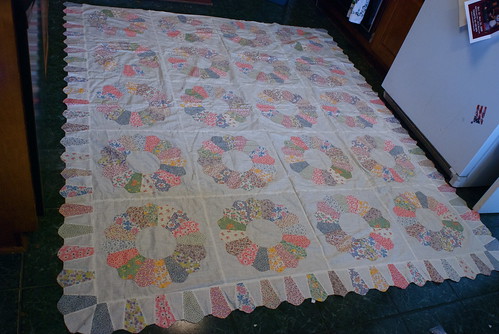Primrose
It's time to introduce you to the changeling quilt top. I didn't make it, and I don't know who did. Say hello to Primrose, named for Primrose Farm, where Catherine's volunteering.
Ever since 'The quilt list: antique, vintage, resale?' I've been keeping a casual, patient eye on eBay to learn what quilt tops are being sold there. I feel like I have a decent handle now on some of the usual suspects -- sellers whose quilt tops are better-made, better-designed, and usually worth checking out. The problem? They know what they're selling, and they know what the market will bear. The better bargains come from people who prowl estate sales but have no useful knowledge of quilts. They see something they like, or think is pretty, pay a few bucks for it, and toss it up for resale to see if anyone bites.
There's a subsection of antique/vintage quilt tops called "cutters." In eBay terms, a "cutter" is one of two things:
- A quilt (or quilt top) so damaged it cannot be wholly salvaged and can only be used for parts
- A piece cut from such a quilt (top)
I normally exclude any quilt top that's labeled as a cutter. For some reason, though, one night, I didn't. Forgetfulness? I spotted this listing and immediately thought I might be on to something:
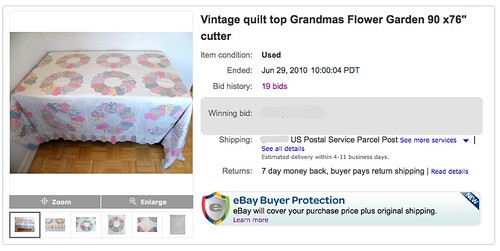 That can't be right.
That can't be right.
['That can't be right.']
How it was described:
- Vintage unfinished quilt in the Grandma's Flower Garden pattern
- Stencilled in pencil in the white area are fleur-de-lis - see 2nd to last photo
- Edges have been finished in pointed patchwork
- Total measurements 90" x 76"
- Excellent handwork
- Overall condition good - no rips or tears, slight discoloration & yellowing in small spots
- Good cutter choice
First, it wasn't a Grandmother's Flower Garden. Even a quick web search would've demonstrated it couldn't possibly be that pattern. Seeing such a major error in the description made me immediately flip through all of the photos to see if there were other errors in the listing. The clincher was in the body of the listing: while the title listed it as a cutter, the body indicated it was in perfect shape for quilting.
I had my winner.
I hoped the word 'cutter' in the title would help shield this listing from some of the sharper-eyed bidders, and I was right. I was able to snag this quilt top for far less than it was worth, and I'm convinced it was because of the multiple mistakes in the listing.
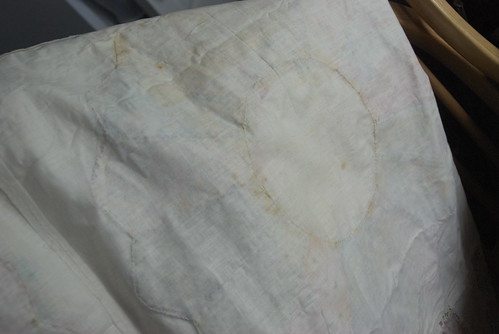 If you hadn't had a bath in 80 years...
If you hadn't had a bath in 80 years...
['If you hadn't had a bath in 80 years...']
It isn't perfect; it has the age spots you would expect from even a well-stored quilt top at this age. Much should come out with a soak in oxygenated cleaner. I don't want to do it immediately, because I don't want to ruin the fleur-de-lis the quilter sketched in the empty spaces with pencil:
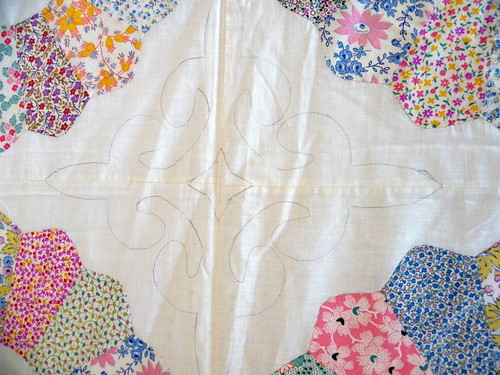 Closeup of penciled-in fleur-de-lis
Closeup of penciled-in fleur-de-lis
['Closeup of penciled-in fleur-de-lis']
What floored me was the discovery that every part of the quilt, even the outer edges, was hand-stitched:
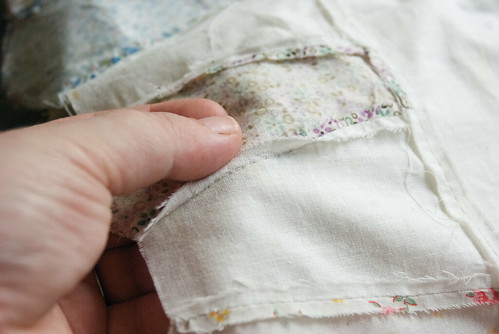 Everything? Even these?
Everything? Even these?
['Everything? Even these?']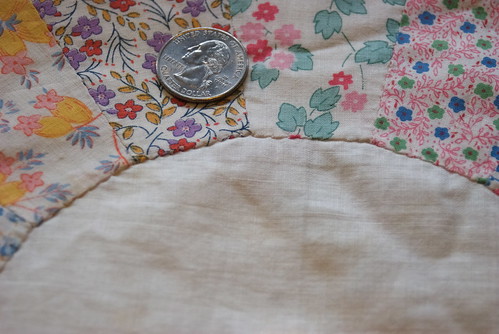 Turn the inside corner
Turn the inside corner
['Turn the inside corner']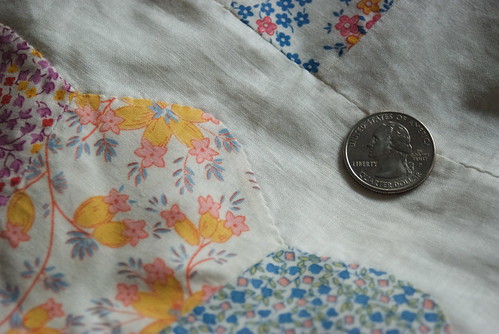 Plate exteriors
Plate exteriors
['Plate exteriors']
There is a small amount of dye migration on a few of the pieces. It's most noticeable in these majority-pink pieces, where you can see the brown has a slight fuzzy halo: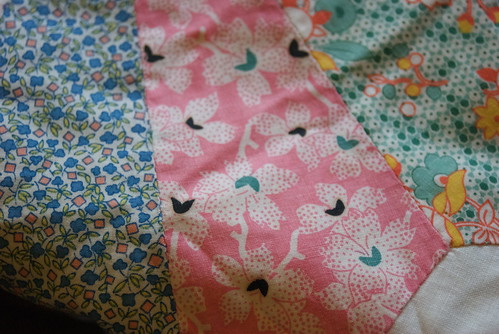 The browns have gone south for winter
The browns have gone south for winter
['The browns have gone south for the winter']
I emailed the seller, to try to find out any information I could on the quilt -- I knew Catherine would want to know. The response:
Hi, I emailed the client who asked me to sell it for her. She's a professional organizer and got it from one of her clients, who got it from someone's else's mom - both of these folks were going to finish it "when they got the time" but never got around to it.
I am GLAD this is finally going to someone who is going to do the right thing! I'm sorry I don't have more info for you. Thank you for buying it. Christine
Here's my unprofessional and unstudied take on it. I hope it's right, but I wouldn't bet my house on it: I think the fabric pieces date to the 1930s. I am not sure if the colored fabrics are indeed feed / flour / sugar sacks, but the printing looks right to me. The pieces feel old, but not as chunky or raw as some of the very definitely feedsack fabrics from Remixed. The white muslin is thinner and different than what we see now. It isn't as robust and thick as modern quilting cotton, but it's not fragile. It's just thinner, and the weave is a little looser. The colored fabrics are spot-on for Depression-era fabrics. I think they're probably legit. I have no idea if that's when the pieces were actually assembled; assembly could have happened significantly later, but then there are those age spots on the back. I don't know how old it is, but I can't come up with a way that it could have those colors, and those age markings, and be newer than the 1940s. I feel pretty confident that we're looking at a quilt top that was pieced 60-80 years ago.
Catherine would have settled for a reproduction quilt and been happy with it; instead she'll get the real thing. My intention is to finish it simply: cotton batting, white backing. Follow the fleur-de-lis quilting marks between the appliquéd plates, echo quilt the interiors and exteriors of the plates (quilt 1/4" away on each side of the seams), and find some sort of appropriate pattern to quilt in the center of each plate. Then maybe something for the edges. I don't know that part yet.
 Straight on until morning
Straight on until morning
['Straight on until morning']
This quilt deserved better than being cut up for parts.
- Log in to post comments

